inflation pressure TOYOTA AVENSIS 2011 Owners Manual
[x] Cancel search | Manufacturer: TOYOTA, Model Year: 2011, Model line: AVENSIS, Model: TOYOTA AVENSIS 2011Pages: 772, PDF Size: 34.43 MB
Page 5 of 772
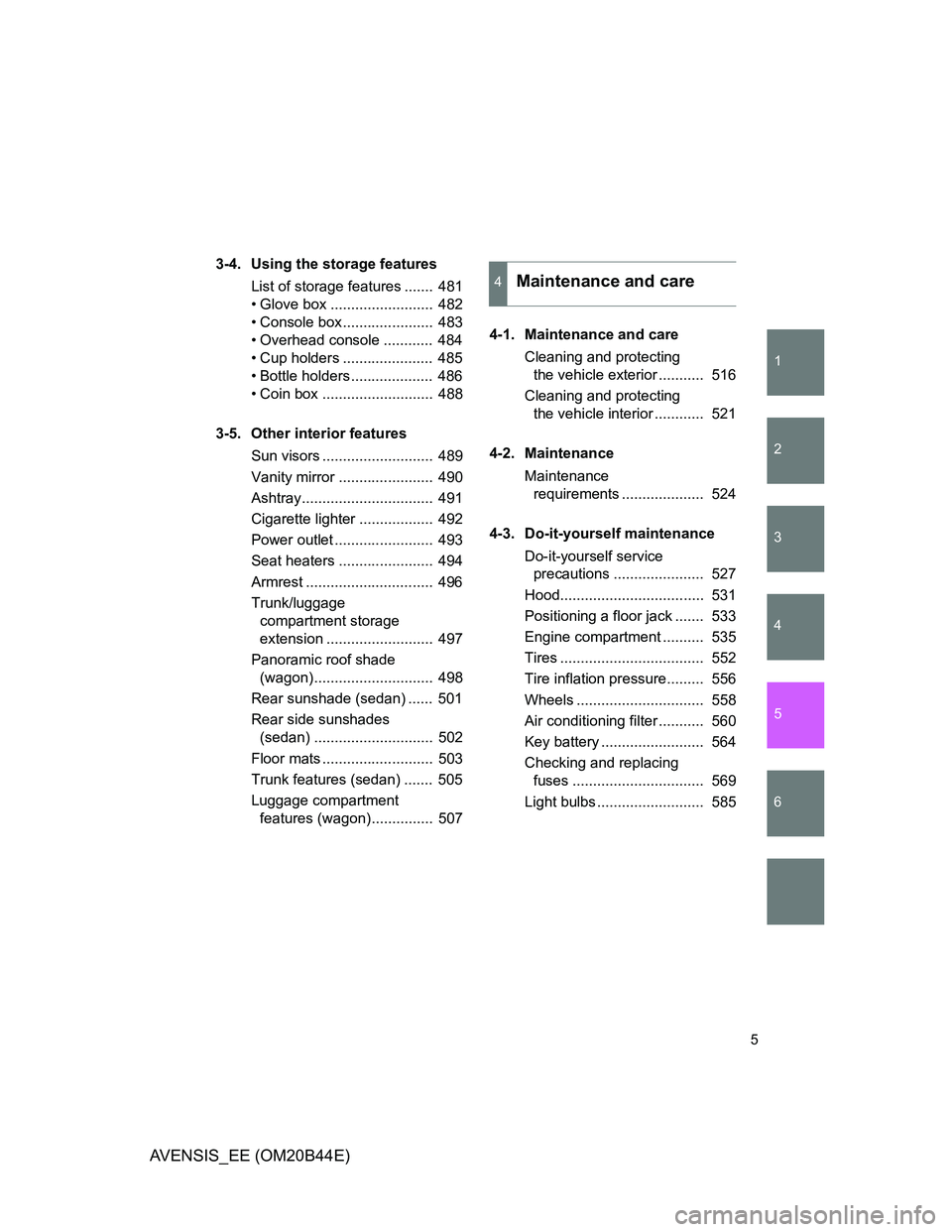
1
2
3
4
5
6
5
AVENSIS_EE (OM20B44E)
3-4. Using the storage features
List of storage features ....... 481
• Glove box ......................... 482
• Console box...................... 483
• Overhead console ............ 484
• Cup holders ...................... 485
• Bottle holders.................... 486
• Coin box ........................... 488
3-5. Other interior features
Sun visors ........................... 489
Vanity mirror ....................... 490
Ashtray................................ 491
Cigarette lighter .................. 492
Power outlet ........................ 493
Seat heaters ....................... 494
Armrest ............................... 496
Trunk/luggage
compartment storage
extension .......................... 497
Panoramic roof shade
(wagon)............................. 498
Rear sunshade (sedan) ...... 501
Rear side sunshades
(sedan) ............................. 502
Floor mats ........................... 503
Trunk features (sedan) ....... 505
Luggage compartment
features (wagon)............... 5074-1. Maintenance and care
Cleaning and protecting
the vehicle exterior ........... 516
Cleaning and protecting
the vehicle interior ............ 521
4-2. Maintenance
Maintenance
requirements .................... 524
4-3. Do-it-yourself maintenance
Do-it-yourself service
precautions ...................... 527
Hood................................... 531
Positioning a floor jack ....... 533
Engine compartment .......... 535
Tires ................................... 552
Tire inflation pressure......... 556
Wheels ............................... 558
Air conditioning filter ........... 560
Key battery ......................... 564
Checking and replacing
fuses ................................ 569
Light bulbs .......................... 585
4Maintenance and care
Page 9 of 772
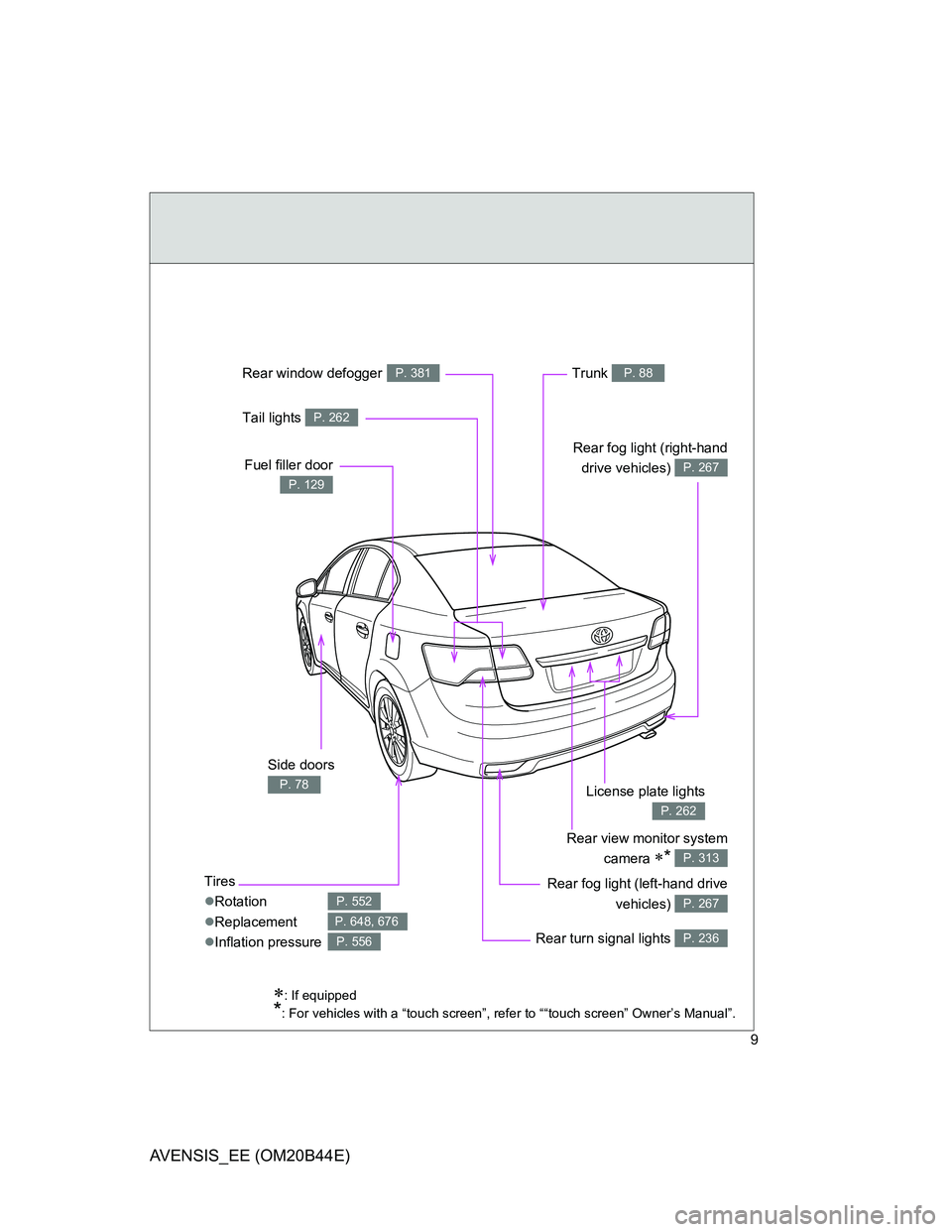
9
AVENSIS_EE (OM20B44E)
Tires
Rotation
Replacement
Inflation pressure
P. 552
P. 648, 676
P. 556
: If equipped
*: For vehicles with a “touch screen”, refer to ““touch screen” Owner’s Manual”.
Trunk P. 88
Side doors
P. 78
Fuel filler door
P. 129
Rear fog light (right-hand
drive vehicles)
P. 267
Rear window defoggerP. 381
Rear view monitor system
camera
* P. 313
Rear fog light (left-hand drive
vehicles)
P. 267
Rear turn signal lights P. 236
License plate lights
P. 262
Tail lights P. 262
Page 11 of 772
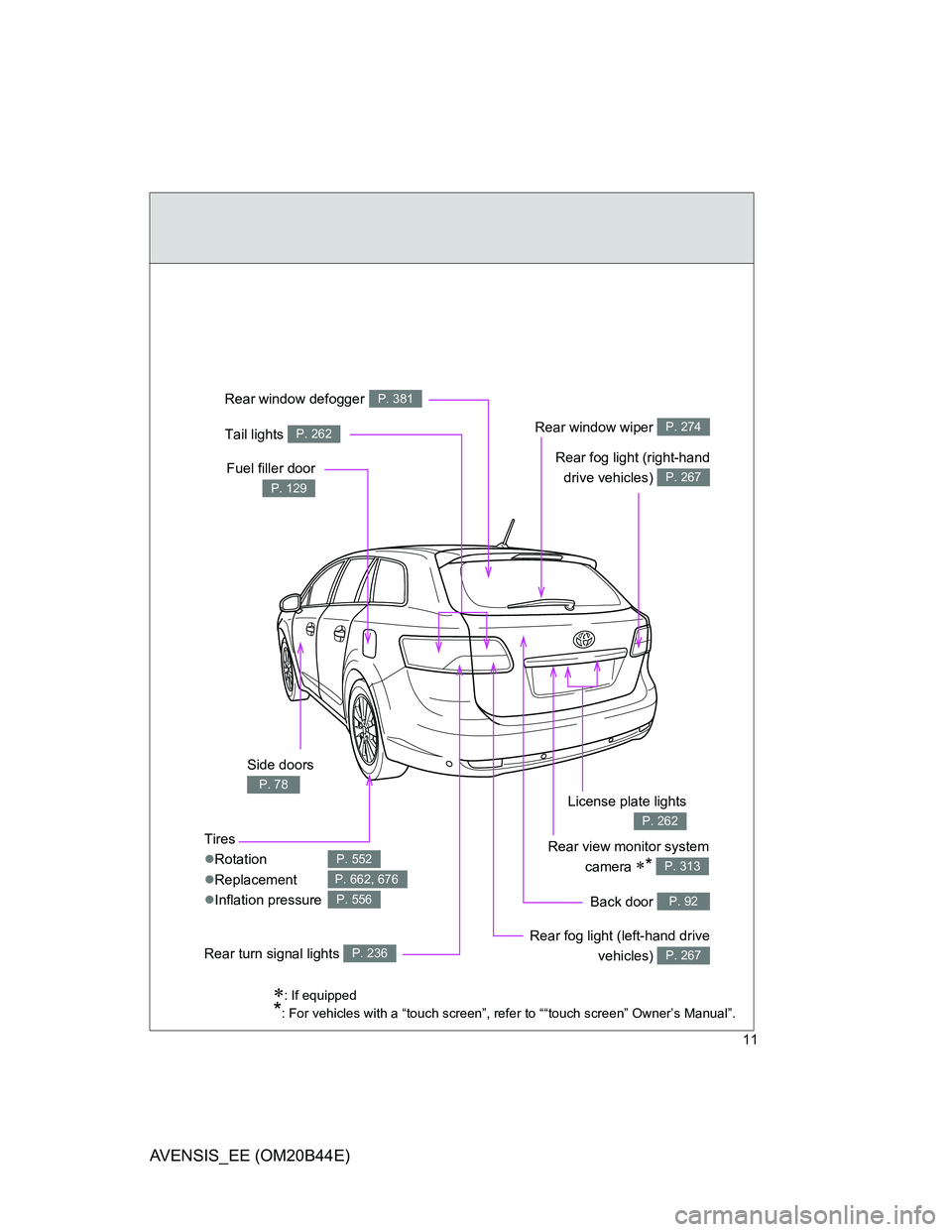
11
AVENSIS_EE (OM20B44E)
: If equipped
*: For vehicles with a “touch screen”, refer to ““touch screen” Owner’s Manual”.
Rear view monitor system
camera
* P. 313
Side doors
P. 78
Tires
Rotation
Replacement
Inflation pressure
P. 552
P. 662, 676
P. 556Back door P. 92
Fuel filler door
P. 129
Tail lights P. 262Rear window wiper P. 274
Rear window defoggerP. 381
License plate lights
P. 262
Rear fog light (left-hand drive
vehicles)
P. 267
Rear fog light (right-hand
drive vehicles)
P. 267
Rear turn signal lights P. 236
Page 325 of 772
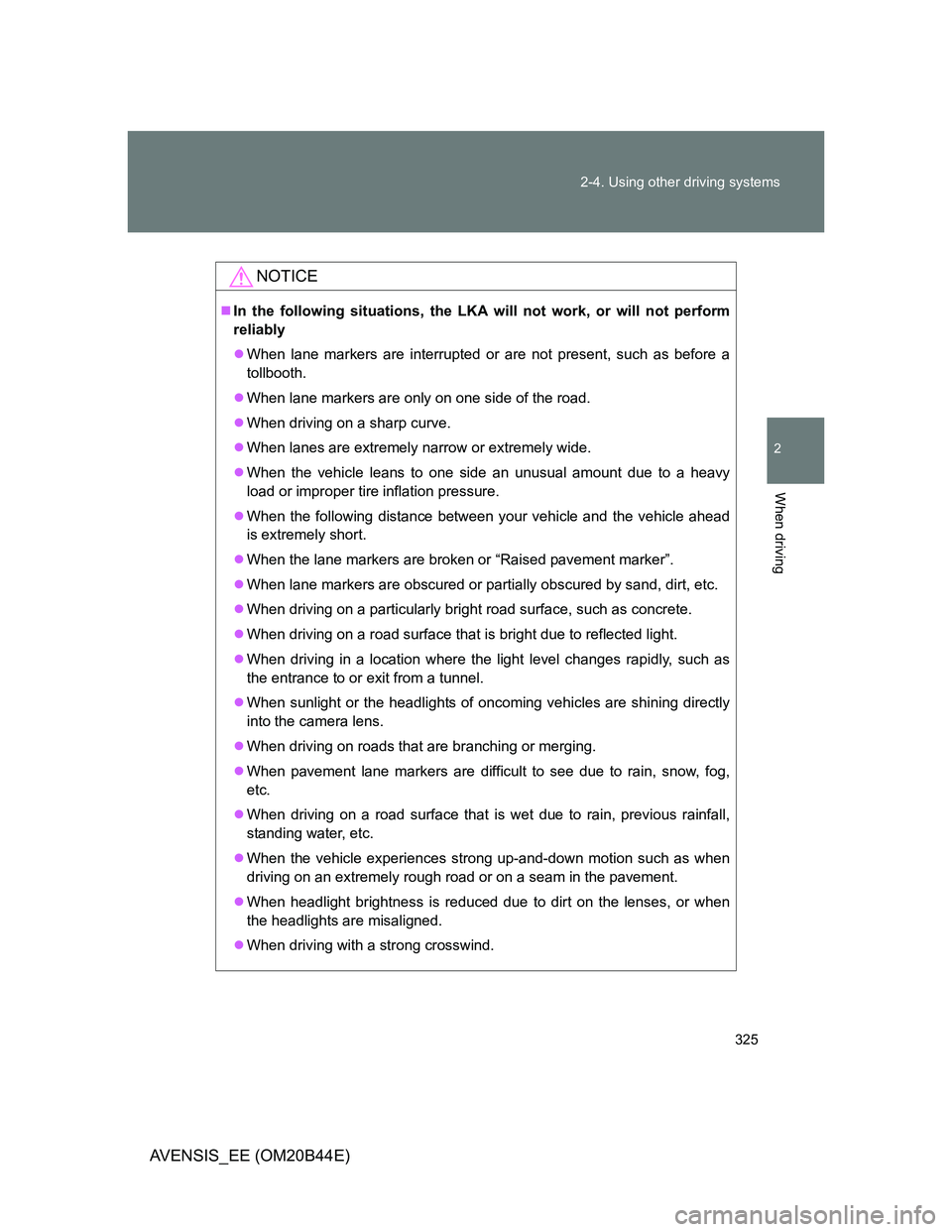
325 2-4. Using other driving systems
2
When driving
AVENSIS_EE (OM20B44E)
NOTICE
In the following situations, the LKA will not work, or will not perform
reliably
When lane markers are interrupted or are not present, such as before a
tollbooth.
When lane markers are only on one side of the road.
When driving on a sharp curve.
When lanes are extremely narrow or extremely wide.
When the vehicle leans to one side an unusual amount due to a heavy
load or improper tire inflation pressure.
When the following distance between your vehicle and the vehicle ahead
is extremely short.
When the lane markers are broken or “Raised pavement marker”.
When lane markers are obscured or partially obscured by sand, dirt, etc.
When driving on a particularly bright road surface, such as concrete.
When driving on a road surface that is bright due to reflected light.
When driving in a location where the light level changes rapidly, such as
the entrance to or exit from a tunnel.
When sunlight or the headlights of oncoming vehicles are shining directly
into the camera lens.
When driving on roads that are branching or merging.
When pavement lane markers are difficult to see due to rain, snow, fog,
etc.
When driving on a road surface that is wet due to rain, previous rainfall,
standing water, etc.
When the vehicle experiences strong up-and-down motion such as when
driving on an extremely rough road or on a seam in the pavement.
When headlight brightness is reduced due to dirt on the lenses, or when
the headlights are misaligned.
When driving with a strong crosswind.
Page 347 of 772
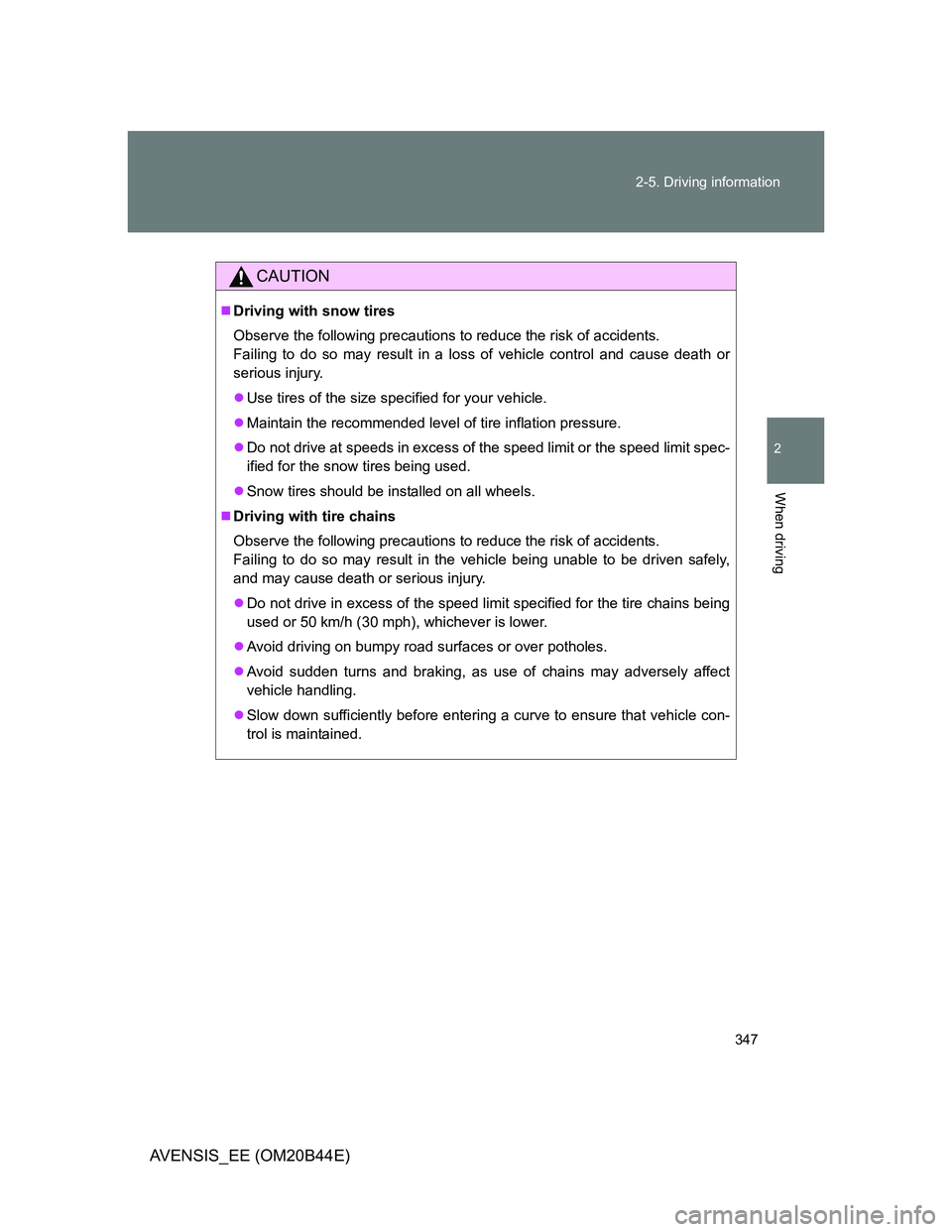
347 2-5. Driving information
2
When driving
AVENSIS_EE (OM20B44E)
CAUTION
Driving with snow tires
Observe the following precautions to reduce the risk of accidents.
Failing to do so may result in a loss of vehicle control and cause death or
serious injury.
Use tires of the size specified for your vehicle.
Maintain the recommended level of tire inflation pressure.
Do not drive at speeds in excess of the speed limit or the speed limit spec-
ified for the snow tires being used.
Snow tires should be installed on all wheels.
Driving with tire chains
Observe the following precautions to reduce the risk of accidents.
Failing to do so may result in the vehicle being unable to be driven safely,
and may cause death or serious injury.
Do not drive in excess of the speed limit specified for the tire chains being
used or 50 km/h (30 mph), whichever is lower.
Avoid driving on bumpy road surfaces or over potholes.
Avoid sudden turns and braking, as use of chains may adversely affect
vehicle handling.
Slow down sufficiently before entering a curve to ensure that vehicle con-
trol is maintained.
Page 515 of 772
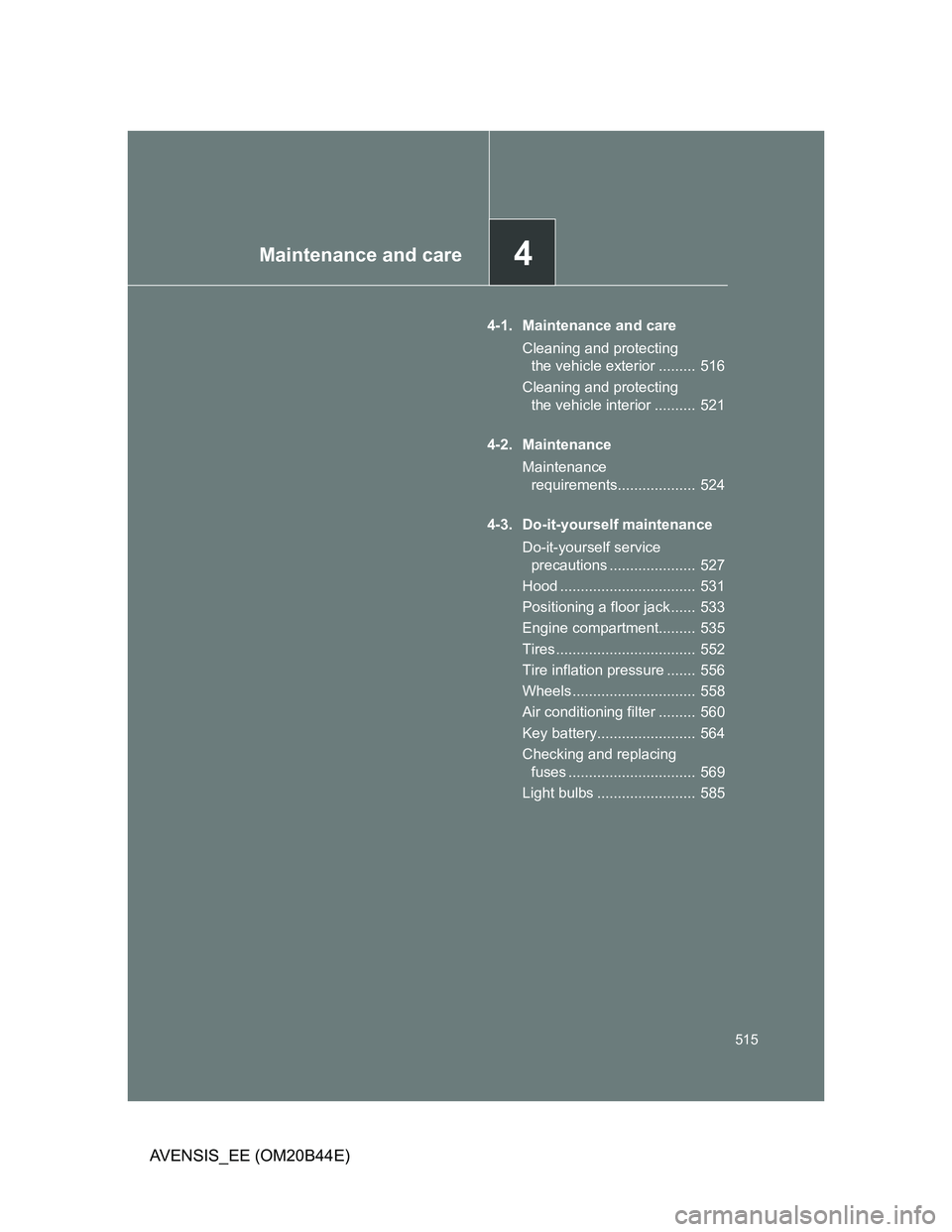
4Maintenance and care
515
AVENSIS_EE (OM20B44E)
4-1. Maintenance and care
Cleaning and protecting
the vehicle exterior ......... 516
Cleaning and protecting
the vehicle interior .......... 521
4-2. Maintenance
Maintenance
requirements................... 524
4-3. Do-it-yourself maintenance
Do-it-yourself service
precautions ..................... 527
Hood ................................. 531
Positioning a floor jack ...... 533
Engine compartment......... 535
Tires .................................. 552
Tire inflation pressure ....... 556
Wheels .............................. 558
Air conditioning filter ......... 560
Key battery........................ 564
Checking and replacing
fuses ............................... 569
Light bulbs ........................ 585
Page 528 of 772
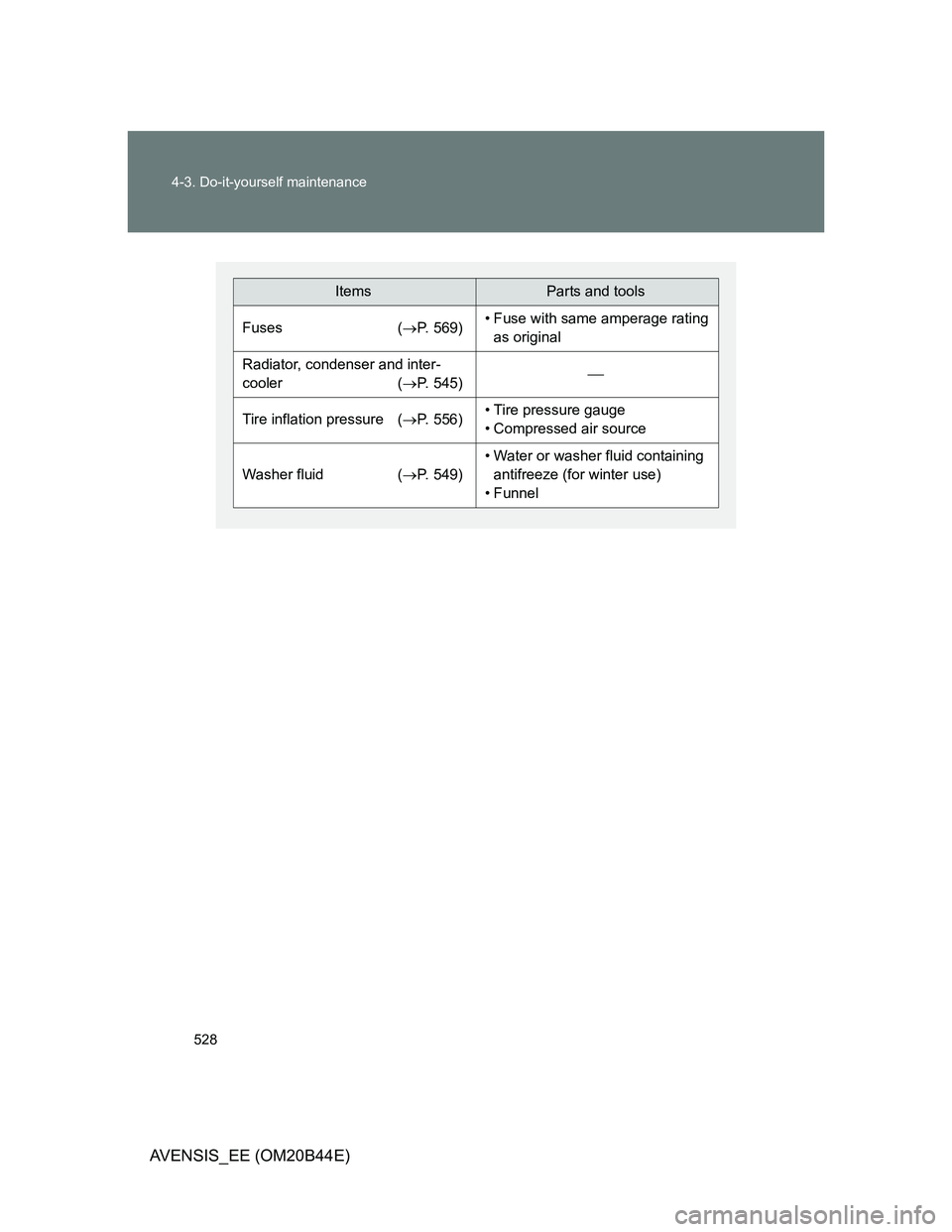
528 4-3. Do-it-yourself maintenance
AVENSIS_EE (OM20B44E)
ItemsParts and tools
Fuses (P. 569)• Fuse with same amperage rating
as original
Radiator, condenser and inter-
cooler (P. 545)
Tire inflation pressure (P. 556)• Tire pressure gauge
• Compressed air source
Washer fluid (P. 549)
• Water or washer fluid containing
antifreeze (for winter use)
• Funnel
Page 552 of 772

552
4-3. Do-it-yourself maintenance
AVENSIS_EE (OM20B44E)
Tires
Replace the tires when the treadwear indicators show.
Checking tires
New tread
Treadwear indicator
Worn tread
The location of treadwear indi-
cators is shown by the “TWI” or
“ ” marks, etc., molded on
the sidewall of each tire.
Check spare tire condition and
inflation pressure if not rotated.
Tire rotation
Vehicles with a spare tire of different wheel type from the
installed tires or an emergency puncture repair kit
Rotate the tires in the order
shown.
To equalize tire wear and help
extend tire life, Toyota recom-
mends that you rotate your
tires approximately every
10000 km (6000 miles).
Front
Page 555 of 772
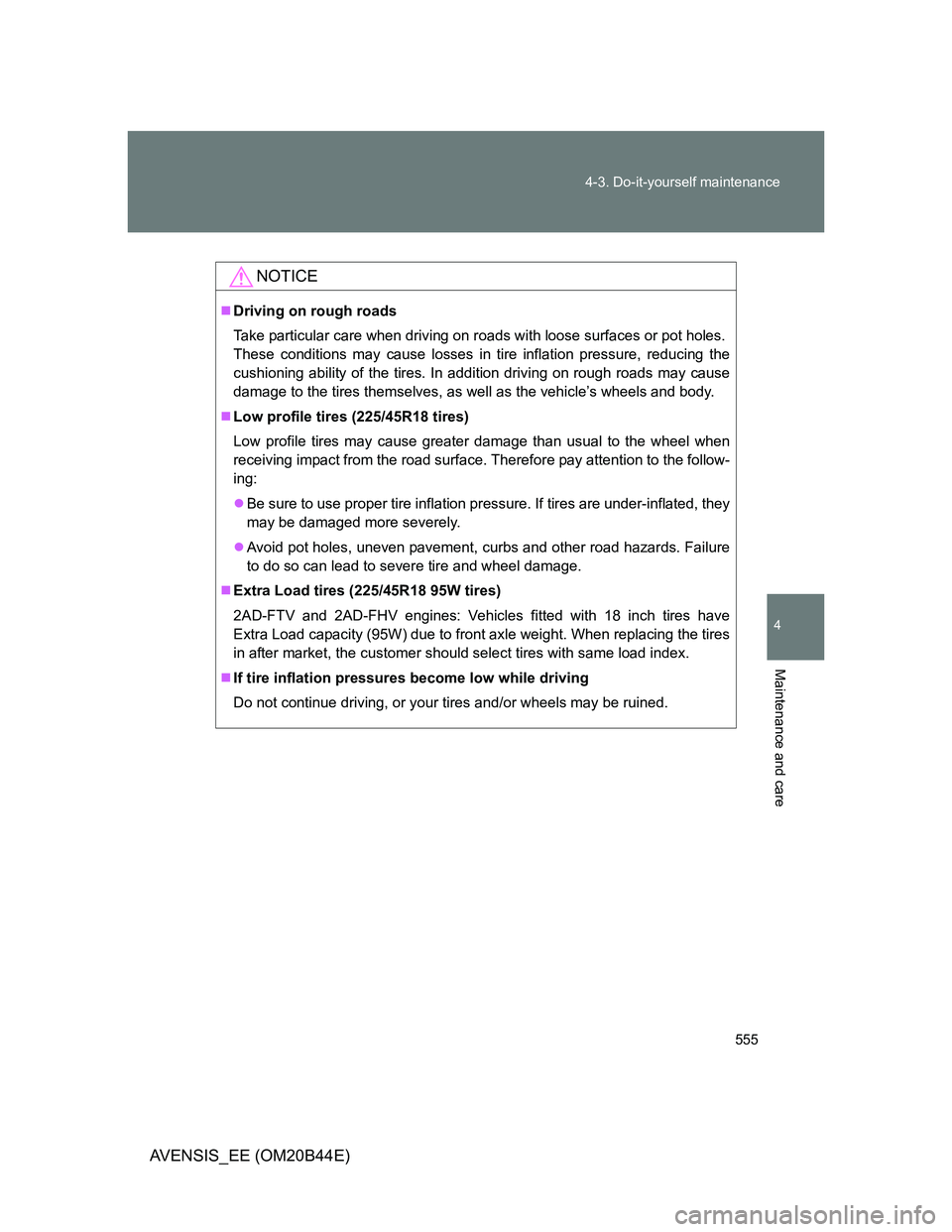
555 4-3. Do-it-yourself maintenance
4
Maintenance and care
AVENSIS_EE (OM20B44E)
NOTICE
Driving on rough roads
Take particular care when driving on roads with loose surfaces or pot holes.
These conditions may cause losses in tire inflation pressure, reducing the
cushioning ability of the tires. In addition driving on rough roads may cause
damage to the tires themselves, as well as the vehicle’s wheels and body.
Low profile tires (225/45R18 tires)
Low profile tires may cause greater damage than usual to the wheel when
receiving impact from the road surface. Therefore pay attention to the follow-
ing:
Be sure to use proper tire inflation pressure. If tires are under-inflated, they
may be damaged more severely.
Avoid pot holes, uneven pavement, curbs and other road hazards. Failure
to do so can lead to severe tire and wheel damage.
Extra Load tires (225/45R18 95W tires)
2AD-FTV and 2AD-FHV engines: Vehicles fitted with 18 inch tires have
Extra Load capacity (95W) due to front axle weight. When replacing the tires
in after market, the customer should select tires with same load index.
If tire inflation pressures become low while driving
Do not continue driving, or your tires and/or wheels may be ruined.
Page 556 of 772

556
4-3. Do-it-yourself maintenance
AVENSIS_EE (OM20B44E)
Tire inflation pressure
Effects of incorrect tire inflation pressure
Driving with incorrect tire inflation pressure may result in the following:
Reduced fuel efficiency
Reduced driving comfort and tire life
Reduced safety
Damage to the drive train
If a tire needs frequent refilling, have it checked by any authorized Toyota
dealer or repairer, or another duly qualified and equipped professional.
Instructions for checking tire inflation pressure
When checking tire inflation pressure, observe the following:
Check only when the tires are cold.
If your vehicle has been parked for at least 3 hours and has not been
driven for more than 1.5 km or 1 mile, you will get an accurate cold tire
inflation pressure reading.
Always use a tire pressure gauge.
The appearance of the tire can be misleading. In addition, tire inflation
pressures that are even just a few pounds off can degrade ride and han-
dling.
Do not bleed or reduce tire inflation pressure after driving. It is normal for
the tire inflation pressure to be higher after driving.
Never exceed the vehicle capacity weight.
Passengers and luggage weight should be placed so that the vehicle is
balanced.
Make sure to maintain the proper tire inflation pressure. Tire inflation
pressure should be checked at least once per month. However,
Toyota recommends that tire inflation pressure be checked once
every two weeks. (P. 739)